Lung Infection or Flu? How to Tell the Difference
When you start feeling under the weather, it can be challenging to determine whether you’re dealing with the flu or a lung infection. Both conditions share some symptoms, but their causes, treatments, and potential complications can be very different. Understanding the differences between the two can help you seek appropriate treatment and avoid unnecessary complications. This comprehensive guide will help you distinguish between lung infections and flu symptoms, leading to better self-diagnosis and treatment.
Understanding the Flu
What is the Flu?
The flu, or influenza, is a viral infection that primarily affects the respiratory system, including the nose, throat, and sometimes the lungs. It’s caused by influenza viruses and is highly contagious, spreading through droplets when an infected person coughs, sneezes, or talks.
Common Symptoms of the Flu
The flu typically comes on suddenly and can include a combination of the following symptoms:
- Fever: High fever, often over 100.4°F (38°C)
- Chills and Sweats: Accompanying the fever
- Headache: Severe headaches are common
- Muscle Aches: Widespread muscle aches and pains
- Fatigue: Intense tiredness and weakness
- Sore Throat: Pain and irritation in the throat
- Runny or Stuffy Nose: Nasal congestion and discharge
- Cough: Persistent, dry cough
- Chest Discomfort: Mild to moderate chest pain
Understanding Lung Infections
What is a Lung Infection?
Lung infections, also known as lower respiratory tract infections, can be caused by bacteria, viruses, fungi, or other microorganisms. They primarily affect the lungs and can range from mild bronchitis to severe pneumonia.
Common Symptoms of Lung Infections
The symptoms of lung infections can vary depending on the type and severity, but common signs include:
- Persistent Cough: Often producing mucus (sputum) that can be clear, yellow, green, or bloody
- Fever: Often lower than flu-related fevers but can be high in severe infections
- Shortness of Breath: Difficulty breathing or feeling winded
- Chest Pain: Sharp or stabbing pain that worsens with deep breaths or coughs
- Fatigue: General sense of tiredness and weakness
- Chills and Sweats: Accompanying fever
- Wheezing: A high-pitched whistling sound when breathing
- Loss of Appetite: Reduced desire to eat
Key Differences Between Flu and Lung Infections
Onset of Symptoms
- Flu: Symptoms appear suddenly and are severe from the start.
- Lung Infections: Symptoms may develop gradually and can vary in intensity.
Cough and Mucus Production
- Flu: Cough is usually dry and non-productive.
- Lung Infections: Cough often produces mucus, which can be clear, yellow, green, or bloody.
Fever and Chills
- Flu: High fever with severe chills and sweats.
- Lung Infections: Fever may be lower and less intense but can be high in severe cases.
Breathing Issues
- Flu: Breathing issues are less common and usually mild.
- Lung Infections: Shortness of breath and wheezing are more common and can be severe.

